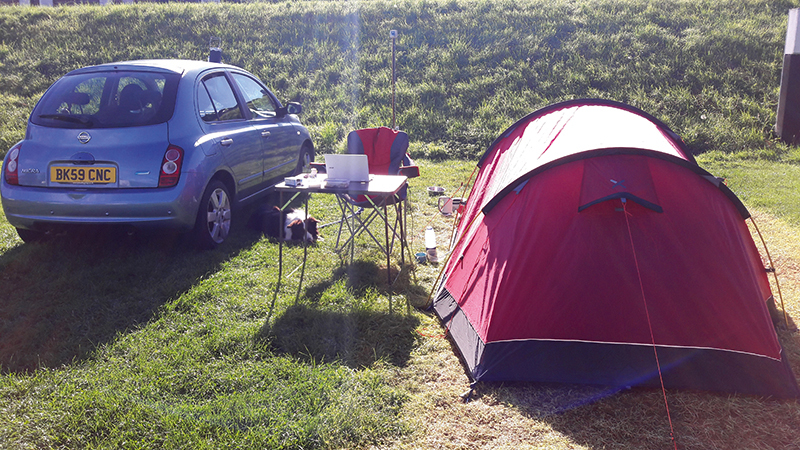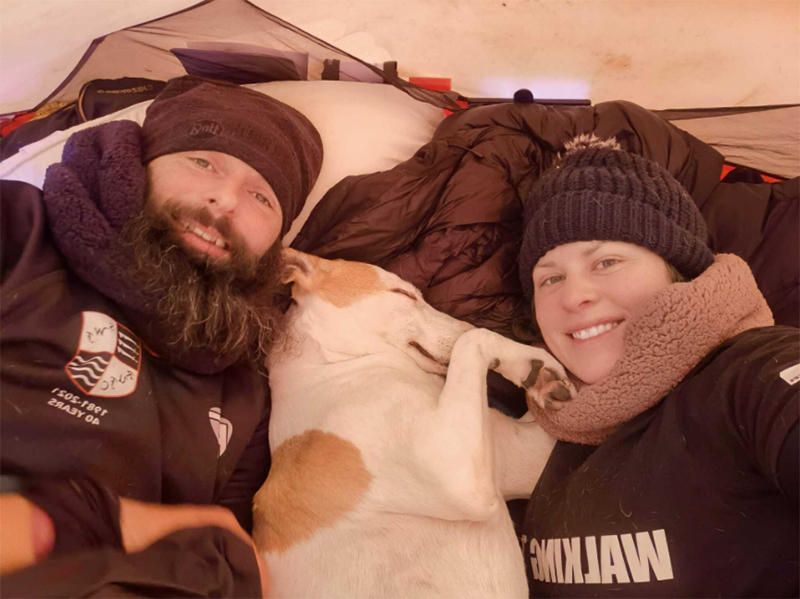Walking has physical and mental benefits for us and our dogs. It can also be a low-cost way to share quality time with your dog, as Julie Hill discovers.
Andrew White, who has shared 10 of his favourite dog walks with us, loves walking, especially with his dogs, and is enthusiastic about sharing the enjoyment with others. As well as being an ambassador for Get Outside, an initiative to inspire people to get the most out of being outdoors, Andrew hosts ‘Walks Around Britain’.
“My dad got me into walking,” he recalled. “He was always an outside sort of person, and he encouraged the outdoor bug in me. When I was at Wolverhampton University
I did more walking — although admittedly it was mainly pub crawls! Then, when I met my wife-to-be, she had Border Collies, and they always want to walk.”
Andrew now shares his life with six Border Collies, and one of them, Mac, regularly accompanies him on longer walks. He has lots of advice to help you enjoy new walks with your dog, starting with how to discover walks in your locality.

If your dog is not as agile as Mac, it is possible to choose easier access walks.
“Ordnance Survey (OS) maps are the best way,” Andrew advised. “We’re all used to the paper maps, but they’ve got a great app now. It’s subscription based, and gives you the ability to have proper OS mapping throughout the country on your phone. You can download tiles of maps in advance, so running out of signal’s not going to be an issue. You can plot routes, and they act like a satnav while you’re walking, which is useful.”
If you have trouble envisaging the landscape from looking at the map, don’t worry, as the app also has an aerial view layer to show you what the terrain actually looks like. One important aspect this view offers is the ability to see whether the area has livestock, although Andrew warned that this is just a snapshot of a specific moment in one day.

Andrew and Mac both enjoy camping on their walking adventures.
“It’s important to keep your dog on-lead until you know there’s no livestock around,” Andrew said. “More countryside livestock is being killed, and in a new location, you just don’t know what’s around the corner — apart from livestock, it could be a road or a railway crossing. All of our dogs go on-lead until there’s a place where it’s absolutely safe to let them off.
“On the TV series, we never let them off-lead and we’ve had a lot of criticism from people who think it’s not a good dog walk if the dog can’t go off-lead. But in my view, that’s wrong; your dog should be able to enjoy being with you, and one of the most fundamental things you have to teach your dog is to walk nicely on-lead.”
Calming sniffing
On-lead walks can be enjoyable, shared experiences. “When our dogs’ leads go on, they go into sniff mode,” said Andrew. “If you let them take time, let them sniff at everything, they end up just as tired because they’ve used their brains. Running off a load of steam is good, but in a situation where you can’t do that, letting them sniff plenty of things is calming.”
Once you’ve explored your local area, you’ll probably want to wander further afield. Andrew recommends honestly assessing your dog. “It’s about knowing your breed, because not all breeds want, or are designed for, long walks. It’s the same for humans — not all of us are going to be trudging up The Three Peaks, or doing all the Monros in Scotland in record time. Know what your individual dog is capable of, and increase the mileage gradually and regularly.”
As well as respecting livestock and wildlife, familiarise yourself with the countryside code. Be aware of what regulations are in place, for example on open access land, between March 1 and July 31, and at all times near livestock, your dog must be on a lead no longer than two metres.
Regulations vary from country to country. “Scotland has a ‘right to roam’, so you can pretty much walk anywhere with some exceptions,” said Andrew. “The downside of this for a novice is that it’s quite daunting to have this big choice, but there are core routes in Scotland that are good to walk.
“Even if you have an older, or less active dog, you can still enjoy a walk. It’s about accessibility. A lot of walks are now designed for people with limited mobility. If you’ve got a dog with mobility issues, you can be fairly certain there isn’t going to be anything that will restrict the dog’s ability to finish the walk, like a stile for example.”
Connect with nature
Longer expeditions may involve overnight stays, for which camping can be a fun option. “You can use a tent as a base, which is a good way of being a part of nature and developing a good relationship with your dog,” said Andrew. “I have a small three-man tent and a camp bed. Normally Mac sleeps underneath or climbs up and sleeps on top of me!”
Wild camping isn’t generally allowed in England and Wales, but there are many dog-friendly campsites. “Camping and caravan club sites are a good option, and if you’re going to do this regularly, you can become a member. Follow the campsite rules; generally, they involve keeping your dog on a short lead and making sure he’s safe at all times,” added Andrew.

Mac has walked many miles with Andrew.
If you haven’t camped before, it’s a good idea to put your tent up in the garden or somewhere close to home beforehand. “If nothing else, just for you to know how to put the tent up,” explained Andrew. “If you’re new to camping, it can be tricky, and the last thing you want is your dog picking up on your stress, and being upset. Make sure that you’re calm — and if you are, your dog will be too.”
Most dogs take to camping very well, but if not you can always opt for a bed and breakfast or hotel instead.
If you’re taking your dog on a trip, Andrew recommends finding out the address of the nearest vet, adding that he also always takes a first aid kit in his rucksack.
Done correctly, discovering new walks with your dog will help keep you both happy and healthy. Summing up, Andrew said: “I’ve always found when I’ve had stresses or challenges in my life, or moments of sadness, a walk has helped to put things into context. Going out with your dog gives you a chance to step away from real life. Even though it seems like everything else is crashing down around you, it’s grounding. It shows you that life goes on no matter what. Your dogs are there — they love you; let’s get on with life!”
Enjoy a shared adventure.
CASE STUDY
“Prioritise your dog before yourself every single time...”
Chris says Jet would walk all day if he didn’t make sure she got enough rest.
After leaving the 2nd Battalion, Parachute Regiment, Chris Lewis had difficulty adapting to civilian life. Now he’s walking the entire UK coastline to raise money for the Soldiers, Sailors, Airmen and Families Association (SSAFA), which provides lifelong support to the Armed Forces and their families. His adventures started back in 2017.
“I was a single parent, and I think I was suffering from depression,” Chris explained. “My daughter left to go to college, and I suddenly found myself on my own. My escape was always being outdoors. I went for a surf one day, looked down the coast, and just thought: ‘Right, I’m going to walk the coast of the UK!’”

Chris Lewis, Kate, and Jet.
Two days later, Chris set off. Nine months later he adopted Lurcher Jet, when her family couldn’t keep her.
“Jet and I hit it off from the very second we got together. The first night in the tent I don’t think I slept, I was just giving her tickles and cuddles to bond with her.”
After meeting his partner, Kate, during the walk, the three of them are now a closely bonded walking team.
“My advice for anybody who wants to do a longer walk with their dog is to know the dog’s limits. Jet would just push on and on, but just like us, dogs need to sleep and rest,” advised Chris.
“Being a Lurcher, Jet gets cold very easily so the first thing I do every single night is make sure she’s fed, watered, and comfortable. I open the tent flaps so she can see what I’m doing. It’s prioritising your dog before yourself every single time that makes for a better camping experience.
Top tips!
- Scout out the area ahead on a map, app, or online.
- Keep your dog on-lead until you’re certain there’s no livestock around.
- Be careful of ground-nesting birds, especially in spring.
- Remember, landowners can put restrictions on open access land.
- Look up where the nearest vet is in advance.
- Check campsites are dog friendly.
- Practise putting up your tent.
- Follow the countryside code.
- Train a good recall.
- Walks designed to accommodate humans with mobility issues will also be more accessible for dogs with mobility issues.
- Carry a canine first aid kit.
- Consider your dog’s needs first.
- Check out the countryside code at www.gov.uk/government/publications/the-countryside-code









